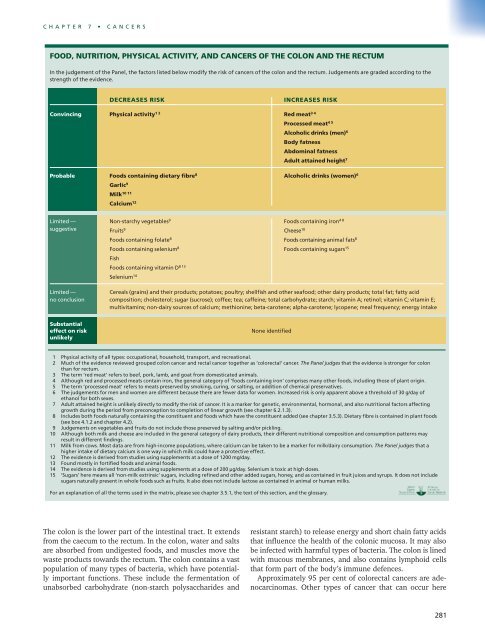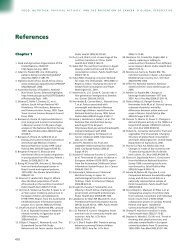Full Report - Food, Nutrition, and the Prevention of Cancer
Full Report - Food, Nutrition, and the Prevention of Cancer
Full Report - Food, Nutrition, and the Prevention of Cancer
You also want an ePaper? Increase the reach of your titles
YUMPU automatically turns print PDFs into web optimized ePapers that Google loves.
CHAPTER 7 • CANCERS<br />
FOOD, NUTRITION, PHYSICAL ACTIVITY, AND CANCERS OF THE COLON AND THE RECTUM<br />
In <strong>the</strong> judgement <strong>of</strong> <strong>the</strong> Panel, <strong>the</strong> factors listed below modify <strong>the</strong> risk <strong>of</strong> cancers <strong>of</strong> <strong>the</strong> colon <strong>and</strong> <strong>the</strong> rectum. Judgements are graded according to <strong>the</strong><br />
strength <strong>of</strong> <strong>the</strong> evidence.<br />
DECREASES RISK INCREASES RISK<br />
Convincing Physical activity1 2 3 4<br />
Red meat<br />
The colon is <strong>the</strong> lower part <strong>of</strong> <strong>the</strong> intestinal tract. It extends<br />
from <strong>the</strong> caecum to <strong>the</strong> rectum. In <strong>the</strong> colon, water <strong>and</strong> salts<br />
are absorbed from undigested foods, <strong>and</strong> muscles move <strong>the</strong><br />
waste products towards <strong>the</strong> rectum. The colon contains a vast<br />
population <strong>of</strong> many types <strong>of</strong> bacteria, which have potentially<br />
important functions. These include <strong>the</strong> fermentation <strong>of</strong><br />
unabsorbed carbohydrate (non-starch polysaccharides <strong>and</strong><br />
4 5<br />
Processed meat<br />
Alcoholic drinks (men) 6<br />
Body fatness<br />
Abdominal fatness<br />
Adult attained height 7<br />
Probable <strong>Food</strong>s containing dietary fibre 8 Alcoholic drinks (women) 6<br />
Garlic 9<br />
10 11 Milk<br />
Calcium 12<br />
Limited — Non-starchy vegetables9 4 8<br />
<strong>Food</strong>s containing iron<br />
suggestive Fruits9 Cheese10 <strong>Food</strong>s containing folate 8 <strong>Food</strong>s containing animal fats 8<br />
<strong>Food</strong>s containing selenium 8 <strong>Food</strong>s containing sugars 15<br />
Fish<br />
8 13<br />
<strong>Food</strong>s containing vitamin D<br />
Selenium 14<br />
Limited — Cereals (grains) <strong>and</strong> <strong>the</strong>ir products; potatoes; poultry; shellfish <strong>and</strong> o<strong>the</strong>r seafood; o<strong>the</strong>r dairy products; total fat; fatty acid<br />
no conclusion composition; cholesterol; sugar (sucrose); c<strong>of</strong>fee; tea; caffeine; total carbohydrate; starch; vitamin A; retinol; vitamin C; vitamin E;<br />
multivitamins; non-dairy sources <strong>of</strong> calcium; methionine; beta-carotene; alpha-carotene; lycopene; meal frequency; energy intake<br />
Substantial<br />
effect on risk None identified<br />
unlikely<br />
1 Physical activity <strong>of</strong> all types: occupational, household, transport, <strong>and</strong> recreational.<br />
2 Much <strong>of</strong> <strong>the</strong> evidence reviewed grouped colon cancer <strong>and</strong> rectal cancer toge<strong>the</strong>r as ‘colorectal’ cancer. The Panel judges that <strong>the</strong> evidence is stronger for colon<br />
than for rectum.<br />
3 The term ‘red meat’ refers to beef, pork, lamb, <strong>and</strong> goat from domesticated animals.<br />
4 Although red <strong>and</strong> processed meats contain iron, <strong>the</strong> general category <strong>of</strong> ‘foods containing iron’ comprises many o<strong>the</strong>r foods, including those <strong>of</strong> plant origin.<br />
5 The term ‘processed meat’ refers to meats preserved by smoking, curing, or salting, or addition <strong>of</strong> chemical preservatives.<br />
6 The judgements for men <strong>and</strong> women are different because <strong>the</strong>re are fewer data for women. Increased risk is only apparent above a threshold <strong>of</strong> 30 g/day <strong>of</strong><br />
ethanol for both sexes.<br />
7 Adult attained height is unlikely directly to modify <strong>the</strong> risk <strong>of</strong> cancer. It is a marker for genetic, environmental, hormonal, <strong>and</strong> also nutritional factors affecting<br />
growth during <strong>the</strong> period from preconception to completion <strong>of</strong> linear growth (see chapter 6.2.1.3).<br />
8 Includes both foods naturally containing <strong>the</strong> constituent <strong>and</strong> foods which have <strong>the</strong> constituent added (see chapter 3.5.3). Dietary fibre is contained in plant foods<br />
(see box 4.1.2 <strong>and</strong> chapter 4.2).<br />
9 Judgements on vegetables <strong>and</strong> fruits do not include those preserved by salting <strong>and</strong>/or pickling.<br />
10 Although both milk <strong>and</strong> cheese are included in <strong>the</strong> general category <strong>of</strong> dairy products, <strong>the</strong>ir different nutritional composition <strong>and</strong> consumption patterns may<br />
result in different findings.<br />
11 Milk from cows. Most data are from high-income populations, where calcium can be taken to be a marker for milk/dairy consumption. The Panel judges that a<br />
higher intake <strong>of</strong> dietary calcium is one way in which milk could have a protective effect.<br />
12 The evidence is derived from studies using supplements at a dose <strong>of</strong> 1200 mg/day.<br />
13 Found mostly in fortified foods <strong>and</strong> animal foods.<br />
14 The evidence is derived from studies using supplements at a dose <strong>of</strong> 200 µg/day. Selenium is toxic at high doses.<br />
15 ‘Sugars’ here means all ‘non-milk extrinsic’ sugars, including refined <strong>and</strong> o<strong>the</strong>r added sugars, honey, <strong>and</strong> as contained in fruit juices <strong>and</strong> syrups. It does not include<br />
sugars naturally present in whole foods such as fruits. It also does not include lactose as contained in animal or human milks.<br />
For an explanation <strong>of</strong> all <strong>the</strong> terms used in <strong>the</strong> matrix, please see chapter 3.5.1, <strong>the</strong> text <strong>of</strong> this section, <strong>and</strong> <strong>the</strong> glossary.<br />
resistant starch) to release energy <strong>and</strong> short chain fatty acids<br />
that influence <strong>the</strong> health <strong>of</strong> <strong>the</strong> colonic mucosa. It may also<br />
be infected with harmful types <strong>of</strong> bacteria. The colon is lined<br />
with mucous membranes, <strong>and</strong> also contains lymphoid cells<br />
that form part <strong>of</strong> <strong>the</strong> body’s immune defences.<br />
Approximately 95 per cent <strong>of</strong> colorectal cancers are adenocarcinomas.<br />
O<strong>the</strong>r types <strong>of</strong> cancer that can occur here<br />
281



